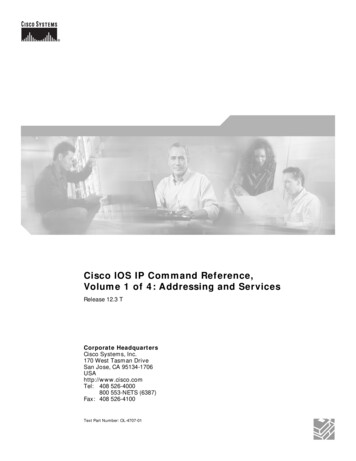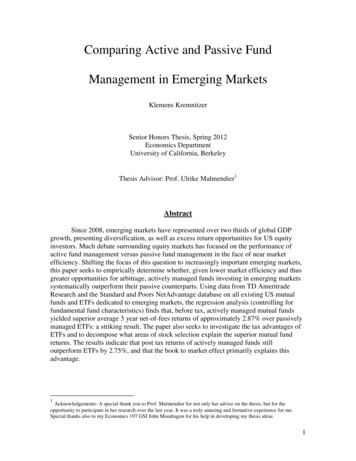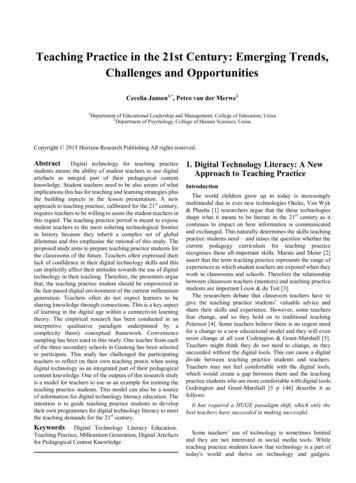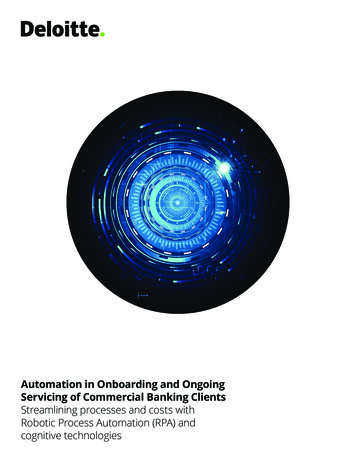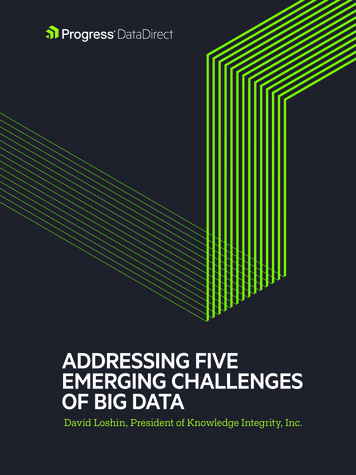
Transcription
ADDRESSING FIVEEMERGING CHALLENGESOF BIG DATADavid Loshin, President of Knowledge Integrity, Inc.
Table of ContentsIntroduction - Big Data Challenges3Challenge #1: Uncertainty of the Data Management LandscapeChallenge #2: The Big Data Talent Gap46Challenge #3: Getting Data into the Big Data Platform7Challenge #4: Synchronization across the Data Sources8Challenge #5: Getting Useful Information out of the Big Data PlatformConsiderations: What Risks Do These Challenges Really Pose?910Conclusion: Addressing the Challenge with a Big Data Integration StrategyAbout the AuthorProgress.com11210
Introduction - Big DataChallengesProgress DataDirect includes ODBC, JDBC and ADO.NET connectors, providingbroad market coverage and addressing many data connectivity challenges seentoday. ISVs can easily embed DataDirect’s connectivity technology for immediateand substantial benefits.Big data technologies are maturing to a point in which more organizations areprepared to pilot and adopt big data as a core component of the informationmanagement and analytics infrastructure. Big data, as a compendium ofemerging disruptive tools and technologies, is positioned as the next great stepin enabling integrated analytics in many common business scenarios.As big data wends its inextricable way into the enterprise, information technology(IT) practitioners and business sponsors alike will bump up against a numberof challenges that must be addressed before any big data program can besuccessful. Five of those challenges are:1. Uncertainty of the Data Management Landscape – There are manycompeting technologies, and within each technical area there are numerousrivals. Our first challenge is making the best choices while not introducingadditional unknowns and risk to big data adoption.2. The Big Data Talent Gap – The excitement around big data applicationsseems to imply that there is a broad community of experts available to helpin implementation. However, this is not yet the case, and the talent gap posesour second challenge.3. Getting Data into the Big Data Platform – The scale and variety of datato be absorbed into a big data environment can overwhelm the unprepareddata practitioner, making data accessibility and integration our thirdchallenge.4. Synchronization Across the Data Sources – As more data sets fromdiverse sources are incorporated into an analytical platform, the potentialfor time lags to impact data currency and consistency becomes our fourthchallenge.Progress.com3
5. Getting Useful Information out of the Big Data Platform – Lastly, usingbig data for different purposes ranging from storage augmentation toenabling high-performance analytics is impeded if the information cannot beadequately provisioned back within the other components of the enterpriseinformation architecture, making big data syndication our fifth challenge.In this paper, we examine these challenges and consider the requirements fortools to help address them. First, we discuss each of the challenges in greaterdetail, and then we look at understanding and quantifying the risks of notaddressing these issues. Finally, we explore how a strategy for data integrationcan be crafted to manage those risks.Challenge 1: Uncertaintyof the Data ManagementLandscapeOne disruptive facet of big data is the use of a variety of innovative datamanagement frameworks whose designs are intended to support bothoperational and to a greater extent, analytical processing. These approachesare generally lumped into a category referred to as NoSQL (that is, “not onlySQL”) frameworks that are differentiated from the conventional relationaldatabase management system paradigm in terms of storage model, data accessmethodology, and are largely designed to meet performance demands forbig data applications (such as managing massive amounts of data and rapidresponse times).There are a number of different NoSQL approaches. Some employ the paradigmof a document store that maintains a hierarchical object representation (usingstandard encoding methods such as XML, JSON, or BSON) associated witheach managed data object or entity. Others are based on the concept of a keyvalue store that allows applications to associate values associated with varyingattributes (as named “keys”) to be associated with each managed object in thedata set, basically enabling a schema-less model. Graph databases maintain theinterconnected relationships among different objects, simplifying social networkanalyses. And other paradigms are continuing to evolve.Progress.com4The wide varietyof NoSQL tools,developers andthe status of themarket are creatinguncertaintywithin the datamanagementlandscape.
Figure 1NoSQL and other innovative datamanagement options arepredicted to grow in 2014 and beyond.1We are still in the relatively early stages of this evolution, with many competingapproaches and companies. In fact, within each of these NoSQL categories,there are dozens of models being developed by a wide contingent oforganizations, both commercial and non-commercial. Each approach is suiteddifferently to key performance dimensions—some models provide greatflexibility, others are eminently scalable in terms of performance while otherssupport a wider range of functionality.In other words, the wide variety of NoSQL tools and developers, and the statusof the market lend a great degree of uncertainty to the data managementlandscape. Choosing a NoSQL tool can be difficult, but committing to the wrongcore data management technology can prove to be a costly error if the selectedvendor’s tool does not live up to expectations, the vendor company fails, or ifthird-party application development tends to adopt different data managementschemes.For any organization seeking to institute big data, the challenge is to propose ameans for your organization to select NoSQL alternatives while mitigating thetechnology risk.1 ”2014 Data Connectivity Outlook paper”; Progress, January 2014Progress.com5
Challenge 2: The BigData Talent GapIt is difficult to peruse the analyst and high-tech media withoutbeing bombarded with content touting the value of big dataanalytics and corresponding reliance on a wide variety ofdisruptive technologies. These new tools range from traditionalrelational database tools with alternative data layouts designed toincreased access speed while decreasing the storage footprint, inmemory analytics, NoSQL data management frameworks, as wellas the broad Hadoop ecosystem.The big data talent gap is real.Consider this statistic: “By 2018,the US alone could face a shortageof 140,000 to 190,000 peoplewith deep analytical skills aswell as 1.5 million managersand analysts with the know-howto use the analysis of big data tomake effective decisions.”There is a growing community of application developers whoare increasing their knowledge of tools like those comprisingthe Hadoop ecosystem. That being said, despite the promotionof these big data technologies, the reality is that there is not a wealth of skills in the market.The typical expert, though, has gained experience through tool implementation and its useas a programming model, rather than the data management aspects. That suggests thatmany big data tools experts remain somewhat naïve when it comes to the practical aspects ofdata modeling, data architecture, and data integration. And in turn, this can lead to less-thensuccessful implementations whose performance is negatively impacted by issues related todata accessibility.And the talent gap is real—consider these statistics: According to analyst firm McKinsey &Company, “By 2018, the United States alone could face a shortage of 140,000 to 190,000people with deep analytical skills as well as 1.5 million managers and analysts with the knowhow to use the analysis of big data to make effective decisions.” 2 And in a report from 2012,“Gartner analysts predicted that by 2015, 4.4 million IT jobs globally will be created to supportbig data with 1.9 million of those jobs in the United States. However, while the jobs will becreated, there is no assurance that there will be employees to fill those positions.” 3There is no doubt that as more data practitioners become engaged, the talent gap willeventually close. But when developers are not adept at addressing these fundamentaldata architecture and data management challenges, the ability to achieve and maintain acompetitive edge through technology adoption will be severely impaired. In essence, for anorganization seeking to deploy a big data framework, the challenge lies in ensuring a level ofthe usability for the big data ecosystem as the proper expertise is brought on board.2 James Manyika, Michael Chui, Brad Brown, Jacques Bughin, Richard Dobbs, Charles Roxburgh, Angela Hung Byers,“Big data: The next frontier for innovation, competition, and productivity,” May 2011, viewed March 10, 20143 Eric Lundquist, “Gartner: 2013 Tech Spending To Hit 3.7 Trillion” October 23, 2012, viewed March 10, 2014Progress.com6
Challenge 3: Getting Datainto the Big Data PlatformIt might seem obvious that the intent of a big data program involvesprocessing or analyzing massive amounts of data. Yet while many peoplehave raised expectations regarding analyzing massive data sets sitting in abig data platform, they may not be aware of the complexity of facilitating theaccess, transmission, and delivery of data from the numerous sources and thenloading those various data sets into the big data platform.The impulse toward establishing the ability to manage and analyze data setsof potentially gargantuan size can overshadow the practical steps needed toseamlessly provision data to the big data environment. The intricate aspectsof data access, movement, and loading are only part of the challenge. Theneed to navigate extraction and transformation is not limited to structuredconventional relational data sets. Analysts increasingly want to import oldermainframe data sets (in VSAM files or IMS structures, for example) and at thesame time want to absorb meaningful representations of objects and conceptsrefined out of different types of unstructured data sources such as emails,texts, tweets, images, graphics, audio files, and videos, all accompanied by theircorresponding metadata.An additional challenge is navigating the response time expectations for loadingdata into the platform. Trying to squeeze massive data volumes through “datapipes” of limited bandwidth will both degrade performance and may evenimpact data currency. This actually implies two challenges for any organizationstarting a big data program. The first involves both cataloging the numerousdata source types expected to be incorporated into the analytical framework andensuring that there are methods for universal data accessibility, while the secondis to understand the performance expectations and ensure that the tools andinfrastructure can handle the volume transfers in a timely manner.Progress.com7Many people maynot be aware ofthe complexityof facilitating theaccess, transmission,and delivery of datafrom the numeroussources and thenloading those datasets into the big dataplatform.
Challenge 4:Synchronization Acrossthe Data SourcesOnce you have figured out how to get data into the big data platform, youbegin to realize that data copies migrated from different sources on differentschedules and at different rates can rapidly get out of synchronization withthe originating systems. There are different aspects of synchrony. From a datacurrency perspective, synchrony implies that the data coming from one sourceis not out of date with data coming from another source. From a semanticsperspective, synchronization implies commonality of data concepts, definitions,metadata, and the like.With conventional data marts and data warehouses, sequences of dataextractions, transformations, and migrations all provide situations in whichthere is a risk for information to become unsynchronized. But as the datavolumes explode and the speed at which updates are expected to be made,ensuring the level of governance typically applied for conventional datamanagement environments becomes much more difficult.The inability to ensure synchrony for big data poses the risk of analyses thatuse inconsistent or potentially even invalid information. If inconsistent datain a conventional data warehouse poses a risk of forwarding faulty analyticalresults to downstream information consumers, allowing more rampantinconsistencies and asynchrony in a big data environment can have a muchmore disastrous effect.Progress.com8The inability toensure synchronyfor big data posesthe risk of analysesthat use inconsistentor potentially eveninvalid information.
Challenge 5: Getting UsefulInformation of the Big DataPlatformMost of the most practical uses cases for big data involvedata availability: augmenting existing data storage as well asproviding access to end users employing business intelligencetools for the purpose of data discovery. These BI tools not onlymust be able to connect to one or more big data platforms, theymust provide transparency to the data consumers to reduce oreliminate the need for custom coding. At the same time, as thenumber of data consumers grows, we can anticipate a need tosupport a rapidly expanding collection of many simultaneoususer accesses. That demand may spike at different times of theday or in reaction to different aspects of business process cycles.Ensuring right-time data availability to the community of dataconsumers becomes a critical success factor.This frames our fifth and final challenge: enabling a means ofmaking data accessible to the different types of downstreamapplications in a way that is seamless and transparent to theconsuming applications while elastically supporting demand.Progress.com9BI tools must be able to connectto one or more big data platforms,provide transparency to thedata consumers and reduce oreliminate the need for customcoding. At the same time, weanticipate the need to support anexpanding collection of manysimultaneous user accesses.
Considerations:What Risks Do TheseChallenges Really Pose?Considering the business impacts of these challenges suggests some seriousrisks to successfully deploying a big data program. In Table 1, we reflect on theimpacts of our challenges and corresponding risks to success.ChallengeImpactRiskUncertainty of themarket landscapeDifficulty in choosing technologycomponents Vendor lock-inCommitting to failing product or failing vendorBig data talent gapSteep learning curve. Extendedtime for design, development,and implementation.Delayed time to valueBig data loadingIncreased cycle time for analytical platform data populationInability to actualize the program due tounmanageable data latenciesSynchronizationData that is inconsistentor out of dateFlawed decisions based on flawed dataBig data accessibilityIncreased complexity insyndicating data to end-userdiscovery toolsInability to appropriately satisfy the growingcommunity of data consumersTable 1: Risks associated with our five big data challengesConclusion: Addressingthe Challenge with Big DataIntegration StrategyIn retrospect, all of our challenges reflect different facets of a more fundamentalissue: the absence of a strategy for integrating big data into the enterpriseenvironment. For example, the difficulty of the technology selection is relatedto the need to ensure the sustainability of the platform that leverages existingenterprise resources while enabling a path for evolving increased datamanagement performance. Likewise for the talent gap and the associated struggleto find people with experience in production-quality big data analytics applicationsthat support existing business processes.Progress.com10
In turn, the last three challenges more acutely demonstrate the big dataintegration risks. Migrating data sets from a wide variety of sources into thebig data platform, ensuring process synchronization and data coherence, andexposing a virtual interface allowing uniform access to the information residingon the big data platform are all examples of capabilities typically provided bydata integration tools and techniques.Examining the challenges and risks suggests that devising a strategy andprogram plan for big data integration can help mitigate those risks. Thestrategy must accommodate all aspects of data availability and accessibilitywhile reducing the need for knowledge of dozens of specialized datamanagement schemes. This strategy must focus on providing a universalmeans for accessing data from multiple sources, moving that data to multipletargets, and instituting a level of abstraction for layering general dataaccessibility.This can be achieved through the development of informed processes thattake advantage of best-of-breed data integration technologies that addressyour evolving challenges and eliminate the correlated risks. Some keycharacteristics of these technologies include: Accessing data stored in a variety of standard configurations (includingXML, JSON, and BSON objects) Relying on standard relational data access methods (such as ODBC/JDBC) Enabling canonical means for virtualizing data accesses to consumerapplications Employ push-down capabilities of a wide variety of data managementsystems (ranging from conventional RDBMS data stores to newer NoSQLapproaches) to optimize data access Rapid application of data transformations as data sets are migrated fromsources to the big data target platformsEfficiently managing today’s big data challenges requires a robust dataintegration strategy backed by leading-edge data technologies and servicesthat lets you easily connect to and access your data, wherever it resides.Progress.com11To mitigate thesechallenges, acomprehensivestrategy andprogram plan for bigdata integration isrequired.
About the AuthorDavid Loshin, president of Knowledge Integrity, Inc, (www.knowledge-integrity.com), is a recognized thought leaderand expert consultant in the areas of analytics, big data, datagovernance, data quality, master data management, and businessintelligence. Along with consulting on numerous data managementprojects over the past 15 years, David is also a prolific authorregarding business intelligence best practices, as the author ofnumerous books and papers on data management, including therecently published “Big Data Analytics: From Strategic Planningto Enterprise Integration with Tools, Techniques, NoSQL, andGraph,” the second edition of “Business Intelligence – The SavvyManager’s Guide,” as well as other books and articles on dataquality, master data management, and data governance. Davidis a frequent invited speaker at conferences, web seminars, andsponsored web sites and channels including www.b-eye-network.com, and shares additional content at his notes and articles atwww.dataqualitybook.com. David can be reached atloshin@knowledge-integrity.com, or at (301) 754-6350.For more information or to talk to a Progress DataDirectrepresentative, visit:www.progress.com/datadirect-connectors.To speak with a Progress DataDirect representative, call:1-800-876-3101About ProgressProgress (NASDAQ: PRGS) is a global leader in application development, empowering the digitaltransformation organizations need to create and sustain engaging user experiences in today’s evolvingmarketplace. With offerings spanning web, mobile and data for on-premise and cloud environments,Progress powers startups and industry titans worldwide, promoting success one customer at a time.Learn about Progress at www.progress.com or 1-781-280-4000.Progress, DataDirect and DataDirect Cloud are trademarks or registered trademarks of ProgressSoftware Corporation and/or one of its subsidiaries or affiliates in the U.S. and/or other countries.Any other trademarks contained herein are the property of their respective owners. 2016 Progress Software Corporation and/or its subsidiaries or affiliates. All rights reserved.Rev 2016/11
data architecture and data management challenges, the ability to achieve and maintain a competitive edge through technology adoption will be severely impaired. In essence, for an organization seeking to deploy a big data
